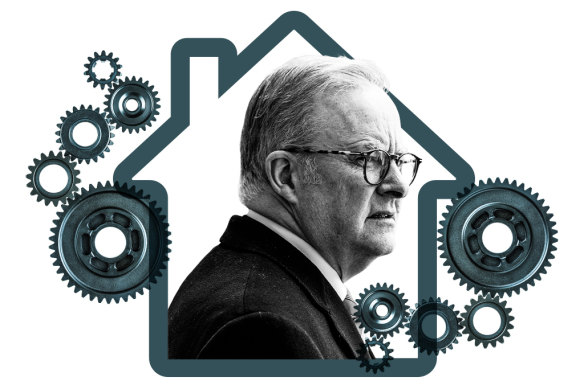This was published 3 months ago
Editorial
Negative gearing changes should not hurt middle income investors
With so many young home buyers being outbid by property investors who can claim a tax benefit, the Albanese government’s move to seek Treasury advice on scaling back negative gearing and capital gains tax concessions is an understandable response to the housing crisis.

Prime Minister Anthony Albanese on negative gearing.Credit: Artwork – Marija Ercegovac
The mooted reform is shaping as a major issue in the coming federal election with the Greens demanding an end to the tax breaks and the Liberals warning against a hit to investors.
The myth is that this is about rich people. It’s not.
The wealthy once were the property owners of Australia. But changes to both bank borrowing policies and tax deductibility legislation helped move swathes of ordinary middle-income Australians into property, either as investments or as an alternative to superannuation for their retirements.
Those changes helped turbocharge the housing market and today the reality is that millions of taxpayers use negative gearing as a legitimate way to claim a tax benefit when the costs of an investment property exceed the income. The Australian Tax Office said there were 2.2 million taxpayers with investment properties. Treasury said about 1.1 million people had a rental loss in 2023 and collected tax benefits worth $2.7 billion.
The simplest reform could be a cap on the number of properties. Of the 2.2 million taxpayers with investment properties, the bulk of so-called “mum and dad investors” are among the 1.6 million landlords with one property. Meanwhile, 423,000 taxpayers had two, 130,000 had three, and about 85,000 owned multiple listings. Another option is a limit on the value of the claims rather than the number of properties. The government could also look at changes to the 50 per cent discount on capital gains tax when properties are sold – a much bigger tax concession.
As the Herald’s chief political correspondent David Crowe pointed out, even if only half were negatively geared last year, many others would have been in the past or will want to explore it in future, and that amounted to more than 14,500 voters in every electorate. While many are in Liberal and “teal” independent seats, negative gearing is not unknown in marginal seats.
Little wonder Labor needs to tread gingerly when formulating changes to housing policy. This sort of reform has a fraught recent electoral history. Former leader Bill Shorten wanted to limit negative gearing to new properties only, reduce the capital gains tax concession from 50 per cent to 25 per cent and curb franking credits, reforms widely regarded as costing him both the 2016 and 2019 elections.
Just as it was in earlier elections, the problem facing government on this intersection of politics and policy is that the reform is custom-made for scare campaigns and destabilising the industry. However, the housing crisis has made continuing inaction untenable.
Whatever Labor decides on negative gearing and the capital gains tax, it is imperative that middle income investors are cushioned against bearing the harshest burden. Their interests could best be protected by introducing the reforms by degrees.
Start the day with a summary of the day’s most important and interesting stories, analysis and insights. Sign up for our Morning Edition newsletter.